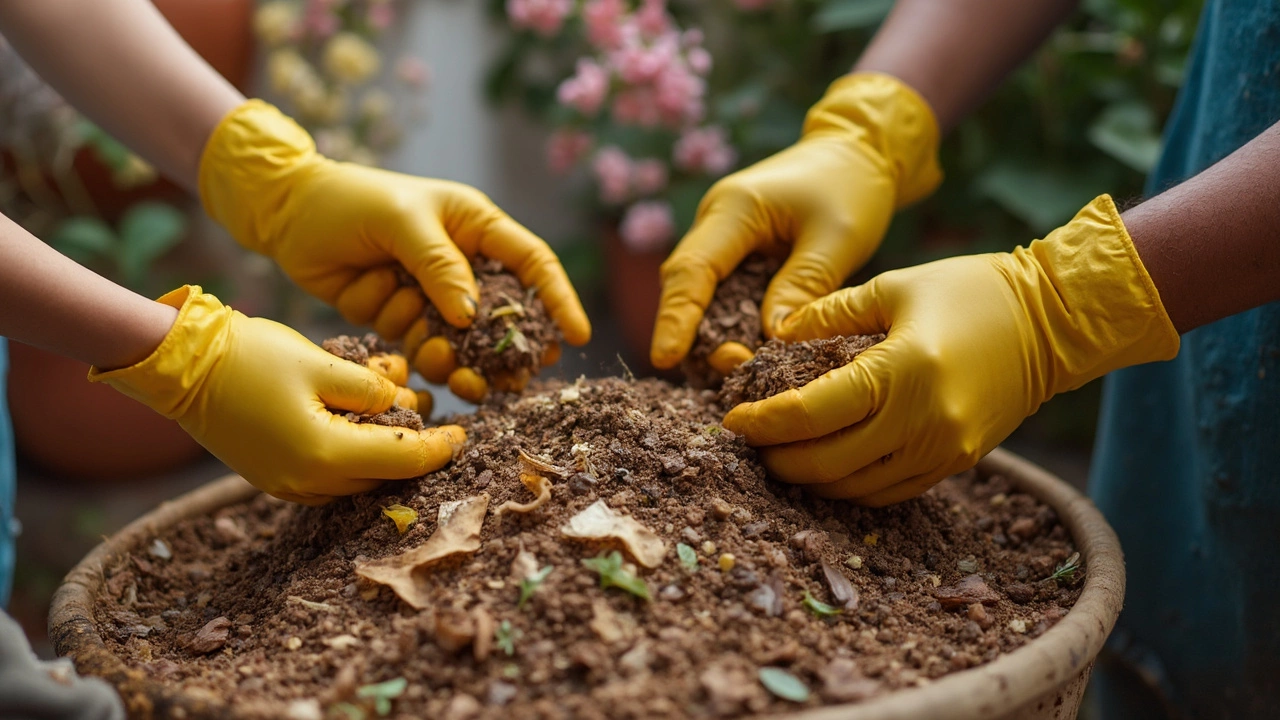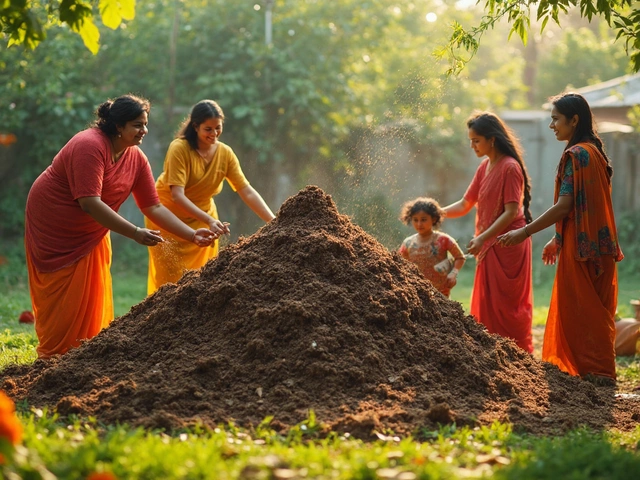Composting doesn’t have to mean sweating in the garden or turning piles every week. Seriously, if you can toss apple peels into a pile, you’re halfway there. Lazy composting is just about making a spot—any spot—where your organic scraps can hang out and break down on their own. No need for expensive bins, complicated setups, or keeping track of mysterious ratios.
Here’s the trick: nature has been composting way before humans made a fuss about it. Even if you chuck your food scraps and leaves in the corner of your yard, eventually, they’ll turn into dark, crumbly compost. That’s it—the laziest way is simply letting time do most of the work. The main thing you need? A place for that pile—hidden behind a shed, next to your fence, or even just a brown paper bag under a bush.
- What Does ‘Lazy Composting’ Really Mean?
- The No-Fuss Composting Methods
- What You Can (and Can’t) Toss In
- Tips to Keep It Smell-Free and Critter-Proof
- How to Use Your ‘Lazy’ Finished Compost
What Does ‘Lazy Composting’ Really Mean?
If you’re looking for the laziest way to compost, get ready for something refreshingly simple. Lazy composting turns the whole process on autopilot. There’s no turning piles with a pitchfork, no fancy thermometer, and definitely no measuring carbon-to-nitrogen ratios. You just pile up your food and yard scraps in one spot and wait for nature to do its thing.
This method is also called cold composting. The breakdown happens slowly, usually over several months to a year. The upside? You get good compost with barely any work. The downside? You’ll need a little patience, and you may want to avoid putting too much meat, dairy, or oily stuff in your pile—those can attract animals and take forever to break down.
People love this approach because it’s low-stress. If you mess up and toss in a weird scrap, no big deal. Rained all month? Forgot about the pile for half a year? You’re probably fine. Choose a shady corner of your yard, make a pile or use a basic bin (even a garbage can with holes works), and you’re almost done.
Here’s how lazy composting stacks up against more hands-on methods:
| Method | Effort Level | Compost Speed |
|---|---|---|
| Lazy/Cold Composting | Almost none | 6-18 months |
| Hot Composting | Frequent turning | 2-3 months |
| Tumbler Composting | Occasional cranking | 3-6 months |
If you just want to feed your garden or plants with something homemade, this style actually works. You don’t even have to get dirty—just add your scraps and ignore it most of the time. Most folks find their pile shrinks down to half its size by the following spring. That’s the magic of lazy composting: your trash turns into treasure, no sweat.
The No-Fuss Composting Methods
When it comes to lazy composting, you don’t need complicated gadgets or perfect weather. There are some solid methods that let you get away with as little effort as possible. Here are the classic go-to moves if you want compost with almost zero work:
- Cold Pile Composting: This is the definition of lazy. Just pile up your grass clippings, food scraps, and leaves in a heap and let nature handle the rest. No turning, no watering unless you’re in a desert, and absolutely zero measuring. The trade-off? It takes longer—anywhere from six months to two years, depending on your local climate and what you’re tossing in. The payoff? Rich compost with no fancy fuss.
- Trench Composting: Also called dig-and-drop. Dig a shallow hole (about a foot deep), throw in your kitchen scraps, then cover it up with soil. Worms and bugs take over from there. You don’t even see the compost as it breaks down, and after a few months, you can plant right on top.
- Sheet Composting: This is sometimes called “composting in place.” Spread a layer of scraps straight onto your garden beds, then cover with leaves or grass clippings. Over time, worms mix it into the soil for you. This works especially well in fall, when you’re prepping beds for spring.
- Bokashi buckets: While it’s a tiny step up in effort (you sprinkle a bran mix over scraps), all you do is toss your kitchen waste in, snap the lid shut, and let it ferment. In about two weeks, your scraps turn into a pickled goop you can bury or add to a traditional compost pile for even faster breakdown.
Here’s a quick look at how these easy compost methods stack up if you want to compare your lazy options:
| Method | Work Required | Finished Compost Time |
|---|---|---|
| Cold Pile | None after setup | 6–24 months |
| Trench | Dig, then nothing | 3–12 months |
| Sheet | Spread and cover | 3–12 months |
| Bokashi | Sprinkle bran, drain liquid | 2 weeks ferment + burial |
If you’re not after instant results, any of these will work. Cold pile is the classic “set and forget.” Trench can double as soil improvement for future garden beds. Sheet composting is good for people who hate walking out to a pile. Bokashi is best if you want to compost indoors and speed things up with less smell. So, pick the no-fuss composting method that matches your mood—the point is, you hardly have to lift a finger.

What You Can (and Can’t) Toss In
If you want lazy composting to work without drama, what you throw in the pile makes all the difference. It’s not just a free-for-all. Some stuff turns into lovely compost; some just causes headaches, smells, or even pests.
Here’s a straight-up breakdown of what’s fair game and what should stay out:
- Fruit and veggie scraps: Apple cores, banana peels, carrot tops, lettuce leaves—basically anything uncooked from your produce drawer.
- Coffee grounds and filters: The whole package goes in, filter and all. Worms love caffeine as much as we do, weird but true.
- Eggshells: Crush them first. They add calcium, even if they take a bit longer to break down.
- Yard clippings: Dry leaves, grass clippings (in moderation), and even those weeds pulled before they go to seed.
- Plain paper and cardboard: Tear up paper towels, toilet paper rolls, and cardboard egg cartons. Skips the shiny, colored stuff.
And here’s what you want to skip if you don’t want smells, pests, or a mess:
- Meat, bones, and dairy: These go rancid quick, and attract raccoons, rats, you name it.
- Oily or fatty foods: Oil takes forever to break down, and nobody wants a greasy compost pile.
- Cooked foods, breads, and pastries: They mold fast and invite critters—keep those out, unless you’re cool with a whole ecosystem moving in.
- Pet waste and litter: Dog and cat poop can carry nasty stuff. Just no.
- Diseased plants or weeds gone to seed: Better safe than sorry.
Want a quick glance? Check out this simple table for a fast yes-or-no:
| Item | Toss In? |
|---|---|
| Banana Peel | Yes |
| Chicken Bones | No |
| Tea Bags | Yes (if no plastic) |
| Paper Towel | Yes |
| Cheese | No |
| Grass Clippings | Yes (in moderation) |
| Weeds with Seeds | No |
| Pet Waste | No |
If you mostly stick to uncooked produce scraps and yard waste, your compost pile will just do its thing—no fuss, no funk, and no wild critter parties at midnight. Easy.
Tips to Keep It Smell-Free and Critter-Proof
Keeping your lazy composting pile from getting stinky or attracting unwanted visitors is easier than you think. The trick is to avoid tossing in the wrong stuff and to know a couple of simple hacks when you set up your pile.
- Bury fresh scraps: Every time you add fruit or veggie peels, cover them up with a handful of leaves, grass clippings, or even plain dirt. This thin layer blocks smells and makes the pile way less interesting to raccoons or your neighbor’s dog.
- Skip the problem items: Meat, dairy, greasy leftovers, and bones are basically an open invite to critters. They also get smelly fast. Stick to fruit, veggie scraps, eggshells, coffee grounds, and small amounts of bread or grains (but only in moderation). If you’re not sure, ask yourself: Would this stink if I left it outside for a day?
- Don’t drown your pile: Too much water means soggy compost and a nasty smell. Rain can do this, so if your pile is open, toss a tarp or old board on top when big storms roll in. On the flip side, if your pile is dry and not breaking down, a splash of water is fine.
- Chop big chunks: Not everyone wants to do this, but cutting up banana peels or pumpkin skins helps them break down faster, which means less chance of catch-the-whiff drama.
- Keep brown stuff handy: Dry leaves, shredded paper, or even sawdust (as long as it’s from untreated wood) are your best friends. Sprinkle some every so often. It balances out the “green” (wet) stuff and keeps things from turning slimy.
You don’t need fancy bins—just knowing where to put your pile makes a difference. If you don’t want to see or smell it, choose a back corner away from windows or patios. A big old plastic storage bin with a few holes poked in it can keep out rodents if you want to double down.
Still worried about pests or odors? Here’s a quick breakdown of common issues and easy fixes:
| Problem | Quick Fix |
|---|---|
| Bad smell | Add more dry leaves or paper, stir it if you can |
| Rats, raccoons | Cover food scraps, use a bin with a lid |
| Mold or gnats | Bury kitchen scraps and keep pile aerated |
Simple as that. Keep these tips in mind and your compost pile will quietly do its thing, no drama required.

How to Use Your ‘Lazy’ Finished Compost
So your lazy composting method actually worked. Now what? Don’t worry, you don’t need to screen it like a pro. Just grab whatever has broken down into that dark, crumbly stuff—ignore the odd eggshell or chunk of avocado pit that’s still hanging around. This stuff is rich in nutrients and ready to give your soil a serious boost.
You’ve got options for how to use it:
- Top-dress your garden beds: Just spread a layer of “almost compost” right on top of your soil. No need to dig it in—rain and worms will drag those nutrients down.
- Feed your potted plants: Mix a scoop into potting soil or just sprinkle on top like a mulch. It slowly releases goodies to roots.
- Side-dress veggies and flowers: Scrape some finished compost around the base of plants a few times during growing season for a boost, especially tomatoes and peppers—they love extra organic waste.
- Start new beds or fix tired soil: Dump your compost and spread it. It’s awesome for starting a fresh raised bed or reviving a patch where nothing wants to grow.
Worried about things not breaking down all the way? Don’t stress. If your compost still has a few ‘chunks,’ it’ll keep decomposing right in the soil. No need to be picky—plants don’t care if there’s a stray peanut shell around.
Here’s a quick look at why easy compost is so good:
| Benefit | What it means |
|---|---|
| Holds moisture | Your soil dries out slower, so less watering needed |
| Adds nutrients | Plants grow stronger, veggies taste better |
| Improves soil texture | DIY fix for clumpy clay or sandy ground |
| Less landfill waste | You’re actually helping the environment, one banana peel at a time |
Don’t forget, beginner compost works for lawns, too. Throw it down before it rains, rake it in gently, and grass will thank you later.



